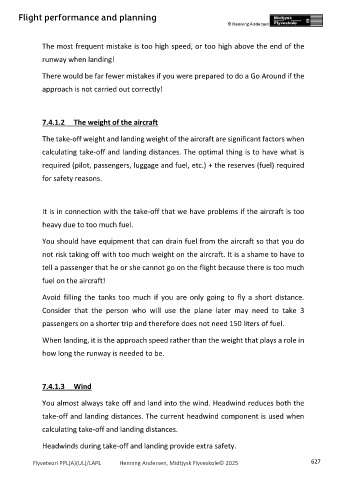Page 627 - PPL-engelsk 2025
P. 627
Flight performance and planning
The most frequent mistake is too high speed, or too high above the end of the
runway when landing!
There would be far fewer mistakes if you were prepared to do a Go Around if the
approach is not carried out correctly!
7.4.1.2 The weight of the aircraft
The take-off weight and landing weight of the aircraft are significant factors when
calculating take-off and landing distances. The optimal thing is to have what is
required (pilot, passengers, luggage and fuel, etc.) + the reserves (fuel) required
for safety reasons.
It is in connection with the take-off that we have problems if the aircraft is too
heavy due to too much fuel.
You should have equipment that can drain fuel from the aircraft so that you do
not risk taking off with too much weight on the aircraft. It is a shame to have to
tell a passenger that he or she cannot go on the flight because there is too much
fuel on the aircraft!
Avoid filling the tanks too much if you are only going to fly a short distance.
Consider that the person who will use the plane later may need to take 3
passengers on a shorter trip and therefore does not need 150 liters of fuel.
When landing, it is the approach speed rather than the weight that plays a role in
how long the runway is needed to be.
7.4.1.3 Wind
You almost always take off and land into the wind. Headwind reduces both the
take-off and landing distances. The current headwind component is used when
calculating take-off and landing distances.
Headwinds during take-off and landing provide extra safety.
Flyveteori PPL(A)(UL)/LAPL Henning Andersen, Midtjysk Flyveskole© 2025 627

